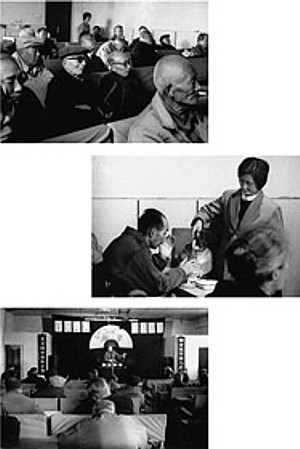History and Milieu (14)

The storytelling event today
Storytelling in Great Enlightenment Storytellers’ House Da guangming shuchang takes place in the afternoon from 2-4 pm. At the entrance to the building there is a ticket office and the customers pay a few coppers to cover both storytelling fee and hot water for tea. The audience, constisting mainly of elderly men who attend the storytelling regularly, arrives well before the time of performance. It is not an expensive and exclusive activity. Most people can afford to attend, if only they have the interest and time to spare, and the daily customers obviously represents the ordinary population of central Yangzhou. Female assistants carry around large kettles of boiling water. People bring their own cups and tea leaves. The formulaic cries of the 'tea master' at the beginning and end of the performance have gone out of use. But the lively chatting, eating of melon seeds, coughing and spitting are features still adding to the cheerful and homely atmosphere.
The session, called ’a day of storytelling’ yitian shu, consists of two parts duanzi with a ten minutes break after the first hour. The storyteller is usually very precise, mounting the stage exactly on time, and first thing, placing his watch on the table. (The watch seems to be indispensable nowadays, although it is never mentioned when the storytellers enumerate the items necessary for performing). He sits on a high chair which will both give him more room for movements and better allow the audience to watch him.
The storyteller is dressed in a long, grey or brown, traditional man's gown chang paozi which is seldom used in ordinary life in Yangzhou, although some old men still like to wear this dress. For regular storytelling in the storytellers' house, male performers usually dress up like this, but in other places, such as schools or hotels, they prefer to perform in ordinary clothes. The female storytellers and storysingers are dressed in slacks and blouse, the normal female dress of today, but they obviously put on their best clothes. They do, however, not wear a particular acctresses’ dress. [This is for example a striking difference from the appearance of female storysingers of Suzhou who dress up in the close-fitting silken dress with slit skirt qipao.]
The moment the storyteller beats the table with his stick, the audience will immediately turn silent, although there might always be a few latecomers jostling for a seat. The audience listens attentively, but the noise from coughing and clearing of throats inevitably forms a continuous accompaniment to the performance. After the first duanzi, the storyteller leaves the stage and retires to a small side room. Cheerful conversation immediately starts buzzing in the resounding hall. The assistants walk around and refill the cups with hot water. Some members of the audience move outside the building to stretch their legs and talk with friends. Some enjoy little snacks that they have brought with them, but there are no vendors of sweets and hot napkins are not available as in the old days.
Exactly on time the storyteller returns and once more begins his tale with a tap of his small stick. When he finishes the second and final part, the audience rises the very moment he says his last sentence and promptly leaves the hall, laughing and chatting. [No applause, as would be expected in the West.] It seems that the audience expresses satisfaction with the performance exactly by the quick reaction in getting up the very second the story comes to an end.
Hui Zhaolong video (8.013Kb)
Hui Zhaolong video (wmv 2.501Kb)